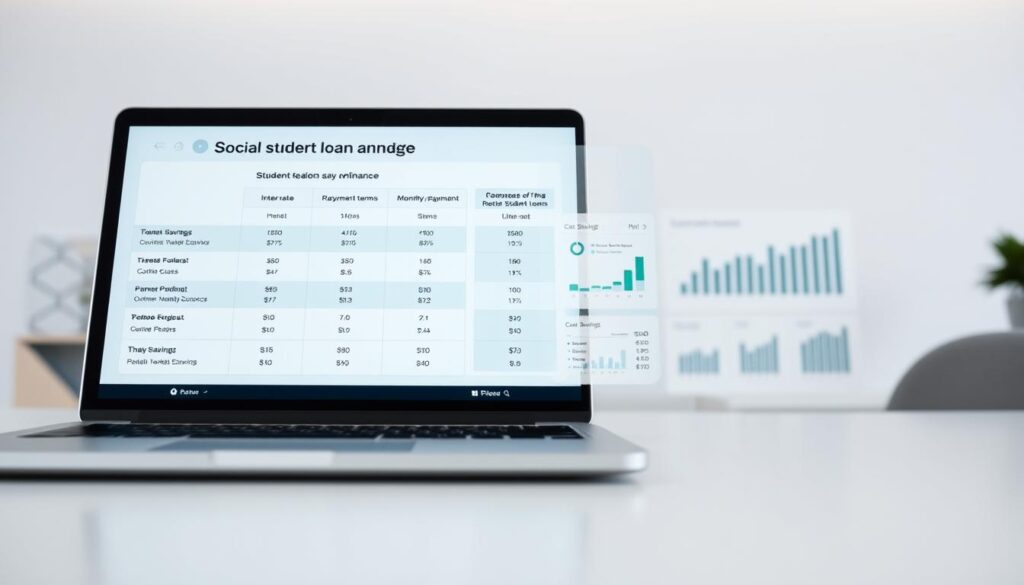Unlock Savings with Our Student Loan Refinance Advice
The Federal Reserve cut interest rates three times in 2024. This has given hope to borrowers that refinancing their debt could be more affordable.
With the chance of lower interest rates coming, now is a great time to look into refinance options for your current debt.
Refinancing can help you lower your monthly payments. This frees up more money in your budget for other things or savings.
We’ll show you how refinancing can save you a lot of money. It can also make your financial obligations easier to handle.
Key Takeaways
- Refinancing can lead to lower monthly payments.
- The current interest rate environment may impact refinance rates.
- Our advice can help you navigate the refinancing process.
- Refinancing can result in significant savings.
- More manageable financial obligations are possible through refinancing.
Understanding Student Loan Refinance
Student loan refinance means getting a new loan with better terms to pay off old debt. When we refinance, we get a new private loan to pay off our old student loans.
What is Student Loan Refinance?
Refinancing student loans involves getting a new loan from a private lender. This loan is used to pay off existing student loans. It simplifies our finances by combining multiple loans into one.
The new loan often has a different interest rate or repayment term. Getting a lower interest rate can save us money over time.
Why Refinance Your Student Loans?
There are good reasons to refinance student loans. One main reason is to get lower interest rates for student loans. This can save us a lot of money. Refinancing also makes managing our finances easier by combining loans into one.
It gives us the chance to switch from a variable to a fixed interest rate, or vice versa. This is helpful when interest rates are rising.
The Benefits of Refinancing
Refinancing student loans has many benefits. By choosing the best student loan refinance options, we can lower our monthly payments. We can also save thousands of dollars in interest over the loan’s life.
- Simplified financial management through loan consolidation
- Potential for lower monthly payments
- Opportunity to secure a lower interest rate
- Flexibility in choosing between fixed and variable interest rates
Types of Student Loans We Can Refinance
Refinancing can help with both federal and private student loans. It combines multiple loans into one, making payments easier. This simplifies managing your monthly finances.
Federal Student Loans
Federal loans are backed by the government and come with various repayment plans. Refinancing federal student loans might lower your interest rate. But, it means losing federal benefits like income-driven plans and Public Service Loan Forgiveness.
Before refinancing federal loans, think about your financial situation and goals. Weigh the pros and cons carefully.
Private Student Loans
Private loans come from banks and credit unions. They have different terms and may lack federal protections. Refinancing can simplify payments and possibly lower your interest rate.
Lenders look at your credit score, income, and more when refinancing private loans. This helps determine the new loan’s terms.
Consolidation Options
Student loan consolidation is a big part of refinancing. It merges multiple loans into one, with a single interest rate and payment. This can save money and make managing your finances easier.
Exploring consolidation options is key. Compare rates and terms from various lenders to find the best for you.
When Should We Consider Refinancing?
Knowing when to refinance is key to improving your student loan plans. Refinancing at the right time can lead to better interest rates and easier payments.
Signs You’re Ready to Refinance
If you’re struggling with loan payments, it might be time to refinance. Signs include a stable income, good credit, and clear financial goals. For example, if your current term is too short, a longer term could help. This could make your monthly payments more affordable.
Timing Our Refinance: Market Conditions
Market conditions are important for refinancing. Interest rates change with the market, and refinancing at low rates can save a lot. Keep an eye on trends and refinance when rates are good.
Personal Financial Situations
Your financial situation matters too. If your income or credit score has improved, you might get better rates. Check your financial health and goals to see if refinancing is right for you.
To see how refinancing affects payments, let’s look at an example:
| Repayment Term | Interest Rate | Monthly Payment |
|---|---|---|
| 10 years | 4.5% | $316 |
| 15 years | 4.2% | $240 |
| 20 years | 4.0% | $202 |
The table shows longer terms mean lower payments. But, remember to consider the total interest paid over time.
How to Choose the Right Lender for Us
Choosing the right lender for our private student loan refinance is key to our financial future. There are many lenders with different terms. It’s important to know what to look for.
Lender Reputation and Reviews
Looking at a lender’s reputation is crucial. We should find lenders known for making customers happy. Online reviews and ratings from trusted sources can help us understand their service and reliability.
Key considerations include:
- Customer service ratings
- Reviews on independent platforms
- Complaint resolution history
Comparing Interest Rates
Interest rates are important for the loan’s cost. We should compare fixed and variable rates from different lenders. Prequalifying with at least three lenders helps us see what’s possible without hurting our credit score.
| Lender | Fixed Interest Rate | Variable Interest Rate |
|---|---|---|
| Lender A | 4.5% | 3.75% |
| Lender B | 4.2% | 3.5% |
| Lender C | 4.8% | 4.0% |
Fees and Additional Costs
Lenders may have fees like origination fees, late fees, and penalties for early payment. Knowing these costs helps us figure out the total cost of refinancing.

By looking at lender reputation, comparing rates, and checking fees, we can choose wisely. This choice should fit our financial goals.
The Refinancing Process Explained
Refinancing your student loans is easier than you think. Many lenders offer online applications. This process replaces your old loan(s) with a new one. It usually has a lower interest rate and better repayment terms.
Refinancing can change your financial life. It might lower your monthly payments or cut down on interest over time. To do it right, you need to know the steps, what documents you’ll need, and how long it takes.
Step-by-Step Overview
First, find a good lender. Then, apply online or by phone. Most lenders let you apply in just minutes.
Here’s what happens when you refinance your student loans:
- Look for lenders with the best rates and terms.
- Fill out an application with your personal and financial info.
- If approved, sign the loan agreement.
- The new lender pays off your old loans, combining them into one.
Required Documentation
To refinance, you’ll need to give your lender some documents. These include:
- Proof of who you are and how much you make.
- Details about your current loans, like account numbers and balances.
- Info about when you graduated and your financial history.
Having these documents ready makes the application process smoother. It can also help you get a decision faster.
Estimated Timeline for Completion
The time it takes to refinance your student loans varies. It depends on the lender and your situation. Here’s a general idea of what to expect:
- From applying to getting approved: 1-5 business days.
- After approval, it takes 1-2 weeks for the new loan to be set up and your old loans to be paid off.
Using a student loan refi calculator can show you how much you might save. It helps you see how refinancing could change your finances.
Potential Risks of Refinancing
Refinancing student loans can have many benefits, but it also comes with risks. It means swapping an old loan for a new one, often with different terms or rates.
One big risk is losing federal loan benefits. When we refinance federal loans, we give up federal perks. This includes income-driven plans and forgiveness options.
Loss of Federal Benefits
Refinancing federal loans can mean losing important benefits. For example, if we’re on an income-driven plan, refinancing could end that. To understand more, check out Bankrate’s article on the pros and cons.
Variable vs. Fixed Interest Rates
Choosing the right interest rate is another risk. Variable rates might start lower, but they can rise, increasing payments. Fixed rates keep payments steady, but might be higher at first.
Before picking, think about your finances and the market. It’s a big decision.
Impact on Credit Score
Refinancing can also affect your credit score. A hard credit check can lower it temporarily. Also, changing your credit mix can impact your score.
To avoid these issues, keep an eye on your credit. Make sure to pay on time with your new loan.
Saving on Interest: What We Can Calculate
To make a smart choice about refinancing, we need to know how to figure out interest savings. Refinancing can lower our interest rates. But, it’s key to understand the numbers involved.
Understanding Calculation Metrics
When we refinance, several things affect our savings. These include the loan amount, original interest rate, new rate, and repayment term. By changing these, we can guess our savings over the loan’s life.
For example, say we have a $30,000 loan with a 6% interest rate and a 10-year term. If we refinance to 4%, we’ll pay less interest over time.
| Loan Amount | Original Interest Rate | New Interest Rate | Total Interest Saved |
|---|---|---|---|
| $30,000 | 6% | 4% | $3,000 |
| $50,000 | 7% | 5% | $6,500 |
Tools for Estimating Savings
Online student loan calculators make it easy to figure out savings. Just enter your loan details, and see your potential savings with a lower rate.
Key benefits of using a student loan calculator include:
- Easy comparison of different loan scenarios
- Instant calculation of potential savings
- Ability to adjust variables such as interest rate and repayment term
Long-Term Financial Projections
It’s important to think about the long-term effects of refinancing. By looking ahead 5 to 10 years, we can see how it will affect our finances.
Refinancing to a lower rate can save us on interest and improve our cash flow. This can help us reach big goals like buying a home or saving for retirement.
By carefully considering our options and using the right tools, we can make an informed decision about whether refinancing our student loans is the right choice for us.
How Refinancing Affects Our Monthly Payments
Refinancing can simplify our finances and might lower our monthly payments. It combines multiple loans into one, making it easier to handle our debt.
Lowering Our Monthly Payment
One big plus of refinancing is the chance to pay less each month. This can happen by getting a lower interest rate or stretching out the loan term. For example, a lower interest rate means more of our payment goes towards the principal, not just interest.
Adjusting Loan Terms
Refinancing lets us change our loan terms. We can pick a longer term for smaller monthly payments or a shorter term to pay off faster. It’s key to think about our current finances and future goals when deciding.
Example of Loan Term Adjustment:
| Loan Term | Monthly Payment | Total Interest Paid |
|---|---|---|
| 10 Years | $200 | $5,000 |
| 15 Years | $150 | $7,000 |
| 20 Years | $120 | $9,500 |
Budgeting for New Payments
After refinancing, we need to plan for our new payments. We should check our income and expenses to see if we can handle the new amount. Making a budget that includes our loan payment helps us manage our money better.
For example, we can divide our income into categories, making sure our loan payment is first.

Understanding how refinancing changes our monthly payments helps us make smart choices. This knowledge lets us better manage our debt and work towards financial stability.
Alternative Options to Refinancing
Looking beyond refinancing, there are other ways to handle student loans. Refinancing can simplify payments and lower interest rates. But, other options might be better for your financial situation.
Income-Driven Repayment Plans
Income-driven plans adjust your monthly payment based on your income. This makes paying back loans easier. There are four main types: Income-Based Repayment (IBR), Income-Contingent Repayment (ICR), Pay As You Earn (PAYE), and the Saving on a Valuable Education (SAVE) Plan. These plans can cut down your monthly payments, making them more affordable.
Key Benefits: Lower monthly payments based on income, potential for loan forgiveness after a certain period.
Loan Forgiveness Programs
Loan forgiveness programs can wipe out part or all of your student loan debt under certain conditions. Programs like Public Service Loan Forgiveness (PSLF) are for those working in public service or non-profit sectors. Other programs might be for teachers, healthcare workers, and more.
Eligibility Criteria: Typically requires working in a qualifying field and meeting specific payment requirements.
Scholarships and Grants
Scholarships and grants are another option, offering money that doesn’t need to be repaid. While often for undergrads, some are for graduate students or help with loan repayment.
- Scholarships may be merit-based or need-based.
- Grants are typically need-based and can come from federal, state, or institutional sources.
Exploring these alternatives can help find the best strategy for managing student loan debt. Whether through income-driven plans, forgiveness programs, or scholarships and grants, there are many ways to handle your loans effectively.
Frequently Asked Questions
There are many ways to refinance student loans. Knowing the common questions can help us make better choices.
Common Concerns Regarding Refinance
Thinking about refinancing student loans can raise many questions. We often wonder, “What are the eligibility criteria for refinancing?” and “How will refinancing affect my credit score?”
- Credit Score: You usually need a credit score of 600s to 700s to qualify for refinance.
- Debt-to-Income Ratio: You should have a debt-to-income ratio of less than 43 percent.
- Steady Income: Having a steady income is key for refinancing.
Knowing these requirements can help us get ready and possibly improve our chances for private student loan refinance.
Myths vs. Facts About Student Loan Refinance
There are many myths about student loan refinance that might stop us from looking into it. Let’s clear up some of these myths and facts.
- Myth: Refinancing student loans always saves us money.
- Fact: Refinancing can offer lower interest rates, but we should also think about the terms and any lost benefits.
Understanding the benefits of student loan refinance, like lower monthly payments and simpler finances, helps us make better choices.
Clarifying the Lost Benefits of Refinancing
One big worry about refinancing federal student loans is losing federal benefits. These include income-driven repayment plans and loan forgiveness programs.
- Assessing the Trade-offs: We need to consider the benefits of refinancing against the loss of federal protections.
- Considering Alternatives: Looking into other options, like income-driven repayment plans or loan forgiveness programs, before deciding to refinance.
By carefully looking at our options and understanding the effects of refinancing, we can choose what’s best for our finances.
Next Steps Towards Refinancing Our Loans
Now that we’ve looked at the good and bad of refinancing our student loans, it’s time to move forward. First, we should check with at least three lenders. This way, we can see what terms they offer without hurting our credit score.
Initial Steps to Take
Using a student loan refi calculator is a smart first step. It helps us figure out how much we could save. With this tool, we can compare different rates and terms to make a better choice.
Resources and Tools We Recommend
Along with the calculator, we suggest looking into different lenders. By comparing what each offers, we can find the best loan for our needs.
Working with Financial Advisors
For advice that’s just for you, think about talking to a financial advisor. They can offer advice that fits your situation. They’ll help us through the refinancing process, making sure we make the right choice.









